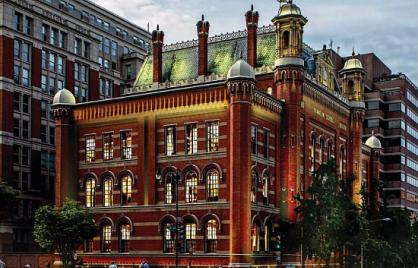
DC UrbanTurf by Nena Perry-Brown
The public got its first detailed look at the proposals for the historic Franklin School on Thursday night, and the team’s plans were filled with trendy brand name concepts.
ANC 2F held a special meeting to vote on which development team they would like to see redevelop the 51,000 square-foot property at the corner of 13th and K Street NW (map), but the meeting was essentially the first time the proposals were presented in the public realm.
Throughout the years, the school has gone from being the flagship of the District’s public education system to serving as a homeless shelter as recently as 2008. In 2012, the Office of the Deputy Mayor of Planning & Economic Development (DMPED) designated the building as eligible for commercial use and developer Eastbanc was named to helm the project. With local art collector/philanthropist Dani Levinas and famed restaurateur Jose Andres on board, the site was pitched as the Institute of Contemporary Expression (ICE), a contemporary art gallery and restaurant. However, current Mayor Muriel Bowser pulled the plug on this plan shortly after taking office last November, opting to request competitive bids from other local development groups.
DMPED and its evaluation panel anticipate selecting a development team for the Franklin School by the end of the year. The primary tenant of the final project will likely have a 50 to 99-year ground lease. Below is a detailed rundown of each of the proposals.
A Soho House For DC
Friedman Collaboration for the Arts (FCA) envisions the building as a “third place” after the home and office, taking its model from Soho House, a trendy club with locations around the world. Approximately 9,000 square feet of the building would serve as a 16-24 room boutique hotel, while 8,000 square feet would be dedicated to a culinary school, art school, gym and performance space. The Museum of Alternative Arts (MOAA) is a primary partner on the proposal. The great hall of the school would be transformed into a restaurant/gallery space to preserve and showcase the pre-existing murals, while the top floor will be used as an indoor/outdoor courtyard.
Soho House has not officially committed to the project, but FCA anticipates having them as the central brand and will retain many elements of that network, including a membership feature. In that sense, the building would offer privileges to its members, such as access to special events and discounts on hotel rates. The fees and dues from club membership, as well as gym dues and other miscellaneous monies collected from events, will cover operating costs at the building.
Arts Focused Hotel With Bar and Restaurant
The proposal from Aria Development Group would transform the school into an innovative hotel/gallery with a bar/restaurant. Aria says that “a hand-selected group of hospitality operators have expressed interest in the project” including European brands 25H (twenty five hours) Hotels and Generator Hostels. Aria is considering a concept for about 65-80 shared hotel rooms aimed at the young professional, student or budget-focused traveler. The great hall would also contain hotel rooms in the form of pods, leaving the art along the walls visible. The 13th Street entrance would remain as it appears, with the addition of a restaurant on that side and a bar/lounge toward the center of the ground floor. That restaurant would join an additional rooftop restaurant as area-wide destinations with well-known chefs at the helm. Cunningham/Quill, the architect for this group, aims to implement green design elements wherever possible.
38,000 Square Feet of Co-Working Space
The team led by Dantes Partners would like to see all 38,000 square feet of the Franklin School used as co-working office space. UberOffices (now known as MakeOffices) would be the primary partner-tenant and would oversee the space. There would be a total of 430 work stations throughout the second, third and fourth floors. Communal conference rooms, phone call rooms and break rooms would be on the ground floor along with a cafe or restaurant. The great hall would be completely preserved and would serve as the hub of the building, with pantry space and an area for public talks and meetings.
Juilliard Meets Y Combinator
Thoron Capital and Georgetown University have partnered in hopes of transforming the Franklin School into an extension of the University that is also open to the public. Overall, the concept is presented as a cross between Silicon Valley incubator Y Combinator and the Juilliard School. It would be a hub of technology, arts and media, as it will offer certification programs, serve as an incubator, and host public events. There will also be community-based courses for Georgetown students which the public can audit, as well as a partnership with various public high schools in the city to teach and train youth and provide college students with community-based learning credits. The grand hall would serve as a performance hall for art and technological events, conferences, and art exhibitions. The plan includes a restaurant facing 13th Street on the ground floor, and the existing courtyard on the side of the building would host the public for live music in the evening. Georgetown would take responsibility for the financing and maintenance of the building, eliminating the need for subsidies from the city.
ANC 2F voted unanimously to recommend that DMPED request the best and final offer, along with a community benefits agreement, from the Thoron Capital/Georgetown University group and the Friedman Collaboration for the Arts. They added to their recommendation the caveat that the final project meet the following criteria: respect for the historic integrity of the structure; long-term financial viability; the generation of tax revenue for the District; public purpose and access (e.g. through the arts, culture, and/or education); compatibility with the District’s overall vision for development and neighborhood revitalization, including attention to the adjacent Franklin Square Park; and employment for city residents.


